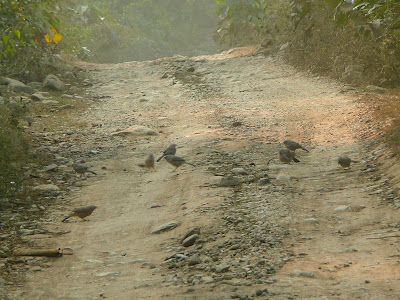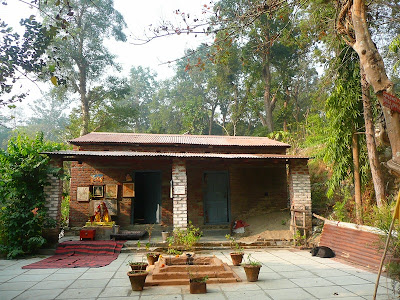L'ouverture d'un magasin de gros du français Carrefour à Jaipur (nord-ouest) a été perturbée lundi par des manifestants opposés à une réforme contestée permettant aux multinationales étrangères d'ouvrir des hypermarchés en Inde, a indiqué mardi la police.
mercredi 30 novembre 2011
Inde: manifestations lors de l'ouverture d'un magasin de gros Carrefour
L'ouverture d'un magasin de gros du français Carrefour à Jaipur (nord-ouest) a été perturbée lundi par des manifestants opposés à une réforme contestée permettant aux multinationales étrangères d'ouvrir des hypermarchés en Inde, a indiqué mardi la police.
Inde: manifestations lors de l'ouverture d'un magasin de gros Carrefour
L'ouverture d'un magasin de gros du français Carrefour à Jaipur (nord-ouest) a été perturbée lundi par des manifestants opposés à une réforme contestée permettant aux multinationales étrangères d'ouvrir des hypermarchés en Inde, a indiqué mardi la police.
Delhi's 100th birthday stirs debate on colonial era
NEW DELHI, Nov 27, 2011 (AFP)
New Delhi reaches 100 next month, not knowing whether to mark the birthday with celebrations of its run-away success or to ignore a date that revives memories of British colonial rule.


New Delhi's 100th birthday gets barely a nod
The Indian capital of New Delhi marked its 100th birthday on Monday without any official celebrations of a day that revives memories of British rule over the country.
jeudi 24 novembre 2011
Un militant "gandhien" prône la flagellation pour les alcooliques
Le militant populiste indien Anna Hazare, soutenu par une immense partie de la population dans sa croisade anticorruption, a provoqué un tollé politique mardi en affirmant qu'il soutenait la flagellation publique pour les alcooliques.
mercredi 23 novembre 2011
La vérité sur les politiques de développement durable...
2011-11-14
COPENHAGEN – When Denmark’s new government ministers presented themselves to Queen Margrethe II last month, the incoming development minister established his green credentials by rolling up to the palace in a tiny, three-wheeled, electric-powered vehicle. The photo opportunity made a powerful statement about the minister’s commitment to the environment – but probably not the one he intended.
Christian Friis Bach’s electric-powered vehicle was incapable of covering the 30 kilometers from his house to the palace without running out of power. So he put the electric mini-car inside a horse trailer and dragged it behind his petrol-powered Citroën for three-quarters of the trip, switching back to the mini-car when he neared the television cameras. The stunt produced more carbon emissions than if he had ditched the electric car and horse trailer and driven a regular car the entire distance.
Unfortunately, the story is not unique. Under the United Kingdom’s Labour government in 2006, Conservative party leader David Cameron attracted attention for trying to “green” his credentials by cycling to work; the tactic went awry when it emerged that a car trailed him carrying his briefcase.
But environmental hypocrisy in current politics runs deeper than photo opportunities. In Denmark, as across the developed world, politicians are promising to fix the globe’s financial mess by overseeing a transition to a greener economy. In the United States, President Barack Obama touts “green jobs.” Australian Prime Minister Julia Gillard has introduced a carbon tax to “enable economic growth without increases in carbon pollution.” And David Cameron was elected Prime Minister on a promise to lead the UK’s “greenest government ever.”
Denmark serves as a useful test of whether these leaders’ preferred policies yield the environmental and economic benefits that they promise. In tune with international enthusiasm for green energy investment, the Danish government intends to expand wind power dramatically by 2020. That is a significant gesture, but, since the country is part of the European Union’s emissions-trading scheme, it will mean absolutely nothing for global CO2 emissions. It will simply make coal power cheaper in other EU countries.
Indeed, costly emission cuts in Denmark and elsewhere are likely to lead to a partial relocation of CO2 emissions to more lenient countries, such as China (where production is less climate-efficient), and thus to an overall increase in global CO2 emissions. The EU has reduced its emissions since 1990, but, at the same time, it has increased imports from China, which alone has produced enough emissions to offset those reductions.
Some will argue that we must implement a comprehensive Kyoto-style agreement to cut emissions globally. But, as we saw at the farcical Copenhagen climate summit in 2009, such an agreement is impossible. Nobody expects a deal to emerge from next month’s summit in Durban, South Africa, and with good reason: even with Democrats in the White House and controlling Congress, the US could not implement an agreement on climate change, while emerging economies, led by China and India, are unwilling to implement measures that would impede growth.
Danish politicians – like politicians elsewhere – claim that a green economy will cost nothing, or may even be a source of new growth. Unfortunately, this is not true. Globally, there is a clear correlation between higher growth rates and higher CO2 emissions. Furthermore, nearly every green energy source is still more expensive than fossil fuels, even when calculating pollution costs. We do not burn fossil fuels simply to annoy environmentalists. We burn them because fossil fuels have facilitated virtually all of the material advances that civilization has achieved over the last few hundred years.
Politicians in Denmark and elsewhere argue as if this were no longer true: a transition to a green economy will create millions of new “green jobs.” But, while green-energy subsidies generate more jobs in green-energy sectors, they also displace similar numbers of jobs elsewhere. This is not surprising: either customers or taxpayers must finance subsidies. Electricity prices will increase, implying a drag on private-sector job creation. If the goal is to create jobs, public investment in other areas – such as the health care – generates stronger, faster employment growth.
To bring the point home, for years Danish politicians have insisted on subsidizing the world’s largest, Danish-based, wind-turbine producer, Vestas, arguing that Denmark wins when other countries spend subsidies on Danish wind-farm technology. But when the Danish Economic Council examined the situation in 2004, it concluded that the country had lost money overall from expenditures on subsidies. More seriously, in today’s tough financial times, the solar and wind industries are downsizing production in expensive countries and shifting employment to cheaper economies. Last year, Vestas dismissed 3,000 employees in Denmark and Sweden.
Many politicians are drawn to photo opportunities and lofty rhetoric about “building a green economy.” Unfortunately, the green-energy policies currently being pursued are not helping the environment or the economy. More likely, they will lead to greater emissions in China, more outsourcing to India, and lower growth rates for the well-intentioned “green” countries.
Bjørn Lomborg is the author of The Skeptical Environmentalist and Cool It, head of the Copenhagen Consensus Center, and an adjunct professor at Copenhagen Business School.
samedi 19 novembre 2011
Jim Corbett National Park
ça commence un vendredi soir, avec un train censé partir à 22h40 de Delhi...
Sérieuse, je reste au boulot jusqu'à 21h (plus pour éviter de repasser chez moi dans le sud alors que la gare est dans le nord...), et à 21h30 je suis déjà à la gare. C'était bien la peine d'être en avance. Le train est retardé et ne partira qu'à... 3h du matin!
censé arriver à Ramnagar à 4h55 initialement, le train de 3h aurait dû arriver à 9h30. Au lieu de cela, ce n'est au'à 11h30 que nous atteignons la ville qui est le point de départ des visites de Jim Corbett National Park, le plus ancien des parc nationaux de l'Inde (créé en 1936), dans l'état de Uttarakhand:


Arrivée à notre hôtel Jungle Paradise (tous les hôtels se situent en bordure est du Parc, au bord de la rivière Kosi), une bonne douche et un bon déjeuner s'imposent...


...avant de partir en "Elephant Safari"! Bizarrement, ils font venir des éléphants (femelles) domestiqués d'Assam, état au nord-est de l'Inde, plutôt que de capturer les éléphants sauvages du parc, trop difficile à dresser et susceptible de retourner à l'état sauvage.


Traversée de la rivière Kosi pour atteindre la forêt, à la tombée du jour, moment où les animaux osent se montrer (mais où la lumière est terrible pour les photos, raison pour laquelle vous ne verrez pas les daims, sangliers, singes, paons et autres oiseaux que nous avons surpris...)







 Le lendemain, levé à 5h pour un "Jeep Safari" dans la forêt, accompagné d'un photographe professionnel en quête de clichés d'oiseaux pour National Geographic et autres magazines.
Le lendemain, levé à 5h pour un "Jeep Safari" dans la forêt, accompagné d'un photographe professionnel en quête de clichés d'oiseaux pour National Geographic et autres magazines.









 Petite pause café près d'un refuge (côté respect de l'environnement, c'est pas gagné...)
Petite pause café près d'un refuge (côté respect de l'environnement, c'est pas gagné...)

 Repos près du temple:
Repos près du temple:



 et retour dans la forêt
et retour dans la forêt avec traversée de la rivière en jeep:
avec traversée de la rivière en jeep: et cours sur la fabrication des termitières...
et cours sur la fabrication des termitières...

Sur la route du village:


 Le moment le plus attendu: Jeep Safari dans le parc!
Le moment le plus attendu: Jeep Safari dans le parc!Baptisé Hailey National Park à sa création en 1936 (Sir Malcolm Hailey était alors le gouverneur britannique des Provinces Unies), Le parc a pris le nom Corbett National Park en 1957, en l'honneur de Jim Corbett, légendaire chasseur devenu protecteur de la faune sauvage, qui se fit surtout connaître par ses chasses aux tigres et léopards d'hommes dans a région.
Le parc est divisé en différentes zones: les "buffer zones" en périphérie, où les villageois sont autorisés à aller chercher du bois pour le feu, les zones touristiques où les jeep safari ont lieu, et les zones réservées aux officiels de forêt pour étudier la faune.
Nous nous rendrons donc dans la zone appelée "Jirna", au sud du parc.
 Encore dans la "buffer zone", nous apercevons au loin un troupeau d'éléphants sauvages...
Encore dans la "buffer zone", nous apercevons au loin un troupeau d'éléphants sauvages... que nous attendrons gentiment de l'autre côté de la barrière d'entrée de la zone touristique!
que nous attendrons gentiment de l'autre côté de la barrière d'entrée de la zone touristique!


Le papa de Bambi!

 et Bambi en question, avec sa famille ;)
et Bambi en question, avec sa famille ;)





 Cabane d'observation
Cabane d'observation

 Martin Pêcheur
Martin Pêcheur Petite pause café au gîte du parc, datant de 1908 (de même que la table en bois au premier plan!)
Petite pause café au gîte du parc, datant de 1908 (de même que la table en bois au premier plan!) également lieu de résidence de nos chers cousins, occupés à se trier les poux...
également lieu de résidence de nos chers cousins, occupés à se trier les poux...







 De nouveau, la nuit tombée ne me permettra pas de prendre de bonnes photos des autres daims et paons qui oseront s'aventurer sur notre route...
De nouveau, la nuit tombée ne me permettra pas de prendre de bonnes photos des autres daims et paons qui oseront s'aventurer sur notre route...Le lendemain, petit balade matinale au bord de la rivière, pour observer les coutumes villageoises...
La lessive:

 La coupe du bois:
La coupe du bois:

 La charge du sable devant servir au ciment:
La charge du sable devant servir au ciment:




Jeux d'enfants:
En période de mousson, la rivière est telle qu'elle emporte tout sur son passage... quelle idée de construire une maison ici?
i

Faune et flore locale:









Pont depuis lequel les plus aventureux s'essaient à la tyrolienne et au rappel:

 Balade en forêt en fin de journée:
Balade en forêt en fin de journée:


 Retour à la gare de Old Delhi de bon matin, avec encore 3h de retard...
Retour à la gare de Old Delhi de bon matin, avec encore 3h de retard... ... direction le bureau sans passer par la case maison!
... direction le bureau sans passer par la case maison!
